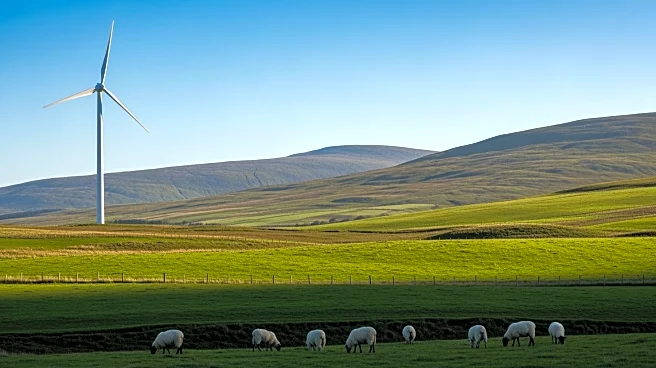What's Happening?
The Scottish government is grappling with the challenge of meeting its carbon emission reduction targets, particularly in the agricultural sector. Despite recommendations from the Climate Change Committee
(CCC) to reduce livestock numbers by 26% by 2035, First Minister John Swinney assured farmers that they would not need to cut livestock numbers. This decision contradicts the CCC's advice, which suggests that nearly half of the required emission reductions should come from decreasing livestock. The government has shifted from annual targets to five-year carbon budgets, aiming for net-zero emissions by 2045. However, the current approach leaves a significant gap in achieving these targets, with a shortfall of about 1.2 million tonnes of carbon dioxide by 2035. Efforts to offset emissions through tree planting and hedgerow expansion are underway, but these measures alone may not suffice.
Why It's Important?
The Scottish government's stance on livestock numbers has significant implications for its climate strategy and the agricultural sector. By not reducing livestock, the government risks falling short of its legally binding emission targets, potentially impacting its credibility and environmental commitments. The decision also affects farmers, who may face future regulatory changes or market pressures to adopt more sustainable practices. Additionally, the broader environmental impact is at stake, as agriculture is a major source of greenhouse gas emissions. The government's approach could influence other regions' policies and contribute to global climate change efforts. The challenge lies in balancing economic interests with environmental responsibilities, highlighting the complexity of achieving sustainable development.
What's Next?
The Scottish government must explore alternative strategies to bridge the emission reduction gap. This could involve accelerating the adoption of electric vehicles, as domestic transport is a significant emission source. Additionally, the government may need to enhance support for carbon capture technologies and renewable energy initiatives. Engaging with stakeholders, including farmers and environmental groups, will be crucial in developing a comprehensive and effective climate action plan. The upcoming policy announcements will be closely watched, as they will indicate the government's commitment to its net-zero goals and its ability to navigate the challenges posed by its current livestock policy.
Beyond the Headlines
The decision to maintain livestock numbers without reduction raises ethical and environmental questions about sustainable farming practices. It underscores the need for innovative solutions in agriculture, such as mob grazing and agroforestry, which can mitigate emissions while supporting biodiversity. The situation also highlights the importance of integrating scientific advice into policy-making, as ignoring expert recommendations could undermine long-term environmental goals. Furthermore, the reliance on natural carbon offsets, like tree planting, emphasizes the need for robust monitoring and management to ensure their effectiveness. The Scottish government's approach may serve as a case study for other regions facing similar challenges in balancing economic and environmental priorities.












